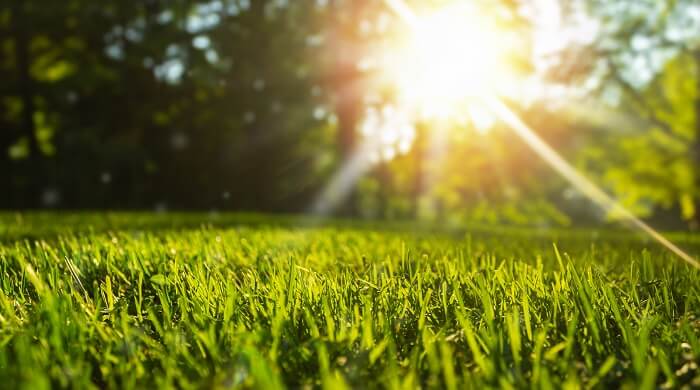
If you love the idea of a lush lawn but live in a drought-prone region, you can still have a beautiful and sustainable patio by planting the best drought-resistant grass for your yard. Don’t fight the sun. Instead, use our guide to help you opt for the best grass for full sun and bring your garden back to life with the ideal choice for your environment.
On This Page
- Best Drought Tolerant Grass
- How to Care for Your Drought Tolerant Lawn Grass
- Best Drought Resistant Grass Alternatives
- FAQs
Best Drought Tolerant Grass
| Type | Advantages | Disadvantages |
|---|---|---|
| Bermuda Grass | Loves sun | Requires frequent mowing |
| St. Augustine | Most drought-tolerant | Prefers dappled sunlight |
| Buffalo Grass | Needs full sun | Grows slowly |
| Fescues | Grows in cool climates | Needs moist soil until established |
| Ryegrass | Highest wear tolerance | Tends to clump |
| Bentgrass | Resilient and attractive | Requires cool nighttime temperatures |
Best Grass for Hot Weather
1. Bermuda
This is the best grass for full sun. Ideal for hot and dry areas, it is a fine textured grass that tends to go dormant in cold weather. It can also be overseeded with ryegrass during the winter. It is traffic tolerant and is often used for athletic fields.
2. St Augustine
With maximum tolerance for dehydration this grass prefers dappled sun rather than direct sunlight. This also means that it remains green during winter months. It spreads quickly but requires good air circulation to avoid diseases, especially during cool times of year.
3. Buffalo
Great choice for areas with extreme summers, this grass also does well in the winter. It prefers heavier clay soils and limited rainfall. It is slower and grows lower than other grasses but is also lower maintenance than others.
Best Grass for Cool Weather
1. Fescues
These cool-season grasses are very tolerant to heat and drought, while remaining green in the wintertime. But they don’t spread very rapidly and require moist soil until they are well-established. Once that happens, they are able to handle dehydration pretty well.
2. Ryegrass
This rapidly growing perennial is great for pastures. It breaks up hard soils and allows roots to absorb nitrogen, to provide superb nutrition for ruminants. It is also great for homeowners because it tolerates high traffic while maintaining a lush appearance.
3. Bentgrass
With a bluish green foliage and a dense mat, Bentgrass is excellent for golf courses, homes and fields. It requires cool nighttime temperatures in order to flourish and will die back in heavy heat periods.
Consult a Pro For Grass Seeding AdviceHow to Care for your Drought Tolerant Lawn Grass
Here are some tips to help you keep your grass looking great:
- Determine if cool or warm weather grass is best for you
- Look for natives at your local nursery
- Choose grass with deep roots
- Make sure you have a healthy soil
- Avoid over-watering
- Mow at species-appropriate height
- Try drip irrigation or harvest rainwater
If you’re still unsure, reach to an expert and find a lawn service. You can hire lawn mowing services near you to keep your grass species at the right height.
Best Drought Resistant Grass Alternatives
When looking for the best drought-resistant grass, it is also important to consider alternatives like moss, sedum and thyme. These options will still provide a lovely green grass cover and help you further reduce your water consumption. You can also create smaller patches of grass surrounded by these other alternatives to create a low-water landscape that is beautiful and part of a low-impact lifestyle.
FAQs
What type of grass is the most drought resistant?
A University of California study shows that the best drought tolerant grass is Bermuda Grass.
What is the easiest grass to maintain?
- Bermuda grass
- Zoysia grass
- Fescues
- Buffalo grass
- St Augustine Grass
How do I keep my grass green without watering?
Stop watering your grass on a regular basis to help it survive periods of drought. Fertilize less frequently and let it grow taller. Once its roots extend deeper into the soil, they will access water that is further underground.
How much does lawn mowing and maintenance cost?
The typical range is between $50 and $220. Use the HomeAdvisor estimator to find the cost to maintain a lawn and grow beautiful grass for your home.
Get Help Choosing Grass For Your Yard
 Dry Well Cleaning & Maintenance Tips
Dry Well Cleaning & Maintenance Tips  Soil Engineers & Testing
Soil Engineers & Testing  Xeriscaping: Environmentally Wise Landscaping
Xeriscaping: Environmentally Wise Landscaping  Mature Tree Care and Tree Removal
Mature Tree Care and Tree Removal  Fall and Winter Landscape
Fall and Winter Landscape 

Are You Familiar With This Topic? Share Your Experience.